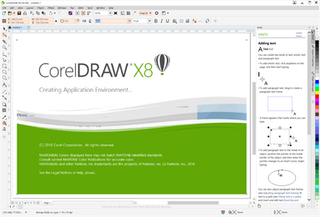Related Research Articles

Xandros, Inc. was a software company which sold Xandros Desktop, a Linux distribution. The name Xandros was derived from the X Window System and the Greek island of Andros. Xandros was founded in May 2001 by Linux Global Partners. The company was headquartered in New York City with its development office in Ottawa, Canada.
Extensible Application Markup Language is a declarative XML-based language developed by Microsoft for initializing structured values and objects. It is available under Microsoft's Open Specification Promise.
The Open Document Format for Office Applications (ODF), also known as OpenDocument, standardized as ISO 26300, is an open file format for word processing documents, spreadsheets, presentations and graphics and using ZIP-compressed XML files. It was developed with the aim of providing an open, XML-based file format specification for office applications.
Online help is topic-oriented, procedural or reference information delivered through computer software. It is a form of user assistance. The purpose of most online help is to assist in using a software application, web application or operating system. However, it can also present information on a broad range of subjects. Online help linked to the application's state is called Context-sensitive help.
A user interface markup language is a markup language that renders and describes graphical user interfaces and controls. Many of these markup languages are dialects of XML and are dependent upon a pre-existing scripting language engine, usually a JavaScript engine, for rendering of controls and extra scriptability.
Windows Presentation Foundation (WPF) is a free and open-source graphical subsystem originally developed by Microsoft for rendering user interfaces in Windows-based applications. WPF, previously known as "Avalon", was initially released as part of .NET Framework 3.0 in 2006. WPF uses DirectX and attempts to provide a consistent programming model for building applications. It separates the user interface from business logic, and resembles similar XML-oriented object models, such as those implemented in XUL and SVG.
A number of vector graphics editors exist for various platforms. Potential users of these editors will make a comparison of vector graphics editors based on factors such as the availability for the user's platform, the software license, the feature set, the merits of the user interface (UI) and the focus of the program. Some programs are more suitable for artistic work while others are better for technical drawings. Another important factor is the application's support of various vector and bitmap image formats for import and export.
Open XML Paper Specification is an open specification for a page description language and a fixed-document format. Microsoft developed it as the XML Paper Specification (XPS). In June 2009, Ecma International adopted it as international standard ECMA-388.
Microsoft Assistance Markup Language is an XML-based markup language developed by the Microsoft User Assistance Platform team to provide user assistance for the Microsoft Windows Vista operating system. It makes up the Assistance Platform on Windows Vista.
Office Open XML is a zipped, XML-based file format developed by Microsoft for representing spreadsheets, charts, presentations and word processing documents. Ecma International standardized the initial version as ECMA-376. ISO and IEC standardized later versions as ISO/IEC 29500.
A proprietary file format is a file format of a company, organization, or individual that contains data that is ordered and stored according to a particular encoding-scheme, designed by the company or organization to be secret, such that the decoding and interpretation of this stored data is easily accomplished only with particular software or hardware that the company itself has developed. The specification of the data encoding format is not released, or underlies non-disclosure agreements. A proprietary format can also be a file format whose encoding is in fact published, but is restricted through licences such that only the company itself or licensees may use it. In contrast, an open format is a file format that is published and free to be used by everybody.

Quick View is a file viewer in Windows 95, Windows 98 and Windows NT 4.0 operating systems. The viewer can be used to view practically any file.

Microsoft Corp. v. Commission is a case brought by the European Commission of the European Union (EU) against Microsoft for abuse of its dominant position in the market. It started as a complaint from Sun Microsystems over Microsoft's licensing practices in 1993, and eventually resulted in the EU ordering Microsoft to divulge certain information about its server products and release a version of Microsoft Windows without Windows Media Player. The European Commission especially focused on the interoperability issue.

Microsoft Silverlight is a discontinued application framework designed for writing and running rich internet applications, similar to Adobe's runtime, Adobe Flash. While early versions of Silverlight focused on streaming media, later versions supported multimedia, graphics, and animation, and gave support to developers for CLI languages and development tools. Silverlight was one of the two application development platforms for Windows Phone, but web pages using Silverlight did not run on the Windows Phone or Windows Mobile versions of Internet Explorer, as there was no Silverlight plugin for Internet Explorer on those platforms.
Opposition to software patents is widespread in the free software community. In response, various mechanisms have been tried to defuse the perceived problem.

David R.R. Webber is an Information technologist specializing in applications of XML, ebXML and EDI to standards-based information exchanges. He is a senior member of the ACM since 2007. David Webber is one of the originators of the ebXML initiative for global electronic business via the internet. He is holder of two U.S. Patents for electronic information exchange transformation and those patents are now cited widely by 37 other patents. David Webber has implemented several unique groundbreaking computer solutions in his career including the world's first airport gate scheduling system , the SeeMail email client for MCIMail written in Prolog, the patented GoXML system for XMLGlobal, the ShroudIt obfuscation system for LNK Corp, and the VisualScript tool for Smartdraw Inc.
The Microsoft Open Specification Promise is a promise by Microsoft, published in September 2006, to not assert its patents, in certain conditions, against implementations of a certain list of specifications.
The Office Open XML file formats, also known as OOXML, were standardised between December 2006 and November 2008, first by the Ecma International consortium, and subsequently, after a contentious standardization process, by the ISO/IEC's Joint Technical Committee 1.

CorelDRAW is a vector graphics editor developed and marketed by Alludo. It is also the name of the Corel graphics suite, which includes the bitmap-image editor Corel Photo-Paint as well as other graphics-related programs. It can serve as a digital painting platform, desktop publishing suite, and is commonly used for production art in signmaking, vinyl and laser cutting and engraving, print-on-demand and other industry processes. Reduced-feature Standard and Essentials versions are also offered.
References
- 1 2 3 "Microsoft Competitors' 'Wow' Moment". microsoft-watch.com. 2007-01-26. Archived from the original on 2013-01-28. Retrieved 2008-02-24.
Today, ECIS (European Committee for Interoperable Systems) again charged that Windows Vista would stifle innovation and competition. The group, founded in 1989, represents a Who's Who list of Microsoft competitors, including Adobe, Corel, IBM, Linspire, Nokia, Opera, Oracle, RealNetworks, Red Hat and Sun. Many of these same companies are Microsoft partners, too.
- 1 2 "ECIS Media Release January 26, 2007". ECIS. 2007-01-26. Retrieved 2008-03-06.
With XAML and OOXML Microsoft seeks to impose its own Windows-dependent standards and displace existing open cross-platform standards which have wide industry acceptance, permit open competition and promote competition-driven innovation. The end result will be the continued absence of any real consumer choice, years of waiting for Microsoft to improve - or even debug - its monopoly products, and of course high prices
- ↑ ECIS News room
- ↑ "Microsoft hit by two more EC probes". The Register. 2008-01-14. Retrieved 2008-02-24.
Commission will also investigate whether the software giant's new office file format, Office Open XML, is interoperable enough with competing products. This refers to a complaint made by the European Committee for Interoperable Systems (ECIS)
- ↑ "Microsoft runs into EU Vista charges". itwire.com. 2007-01-28. Archived from the original on 2008-09-13. Retrieved 2008-02-24.
The main complaint is Microsoft's bundling of its own markup language XAML with Vista. According to ECIS, XAML has been positioned to compete with the universally used HTML (hypertext markup language), which is the code used to design web pages of sites in use today. ECIS contends that bundling XAML with Vista is an attempt to promote the creation of websites that work only with Vista.
- ↑ Fulton, Scott (2007-01-28). "ECIS Accuses Microsoft of Plotting HTML Hijack". betanews.com. Retrieved 2008-02-24.